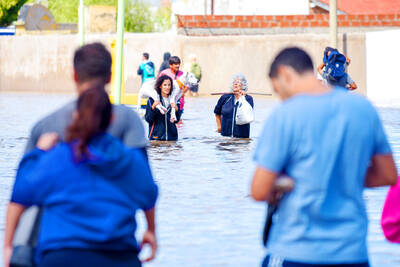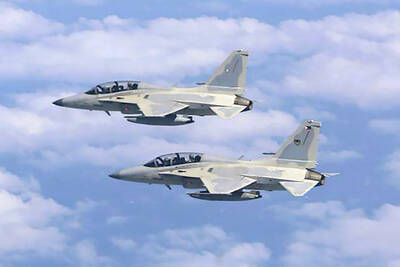For 40 years, this base on the coast of French Guiana has been the prestigious symbol of French, and then European, ambitions in space. But today, the Guiana Space Center is girding for a new era when it will host Russian rockets and engineers who just a short while ago were Europe’s space rivals.
A freighter was due to dock in Cayenne today, bearing a first consignment of 150 containers of equipment to fit out a launch pad at the center, where, from the second half of next year, the first “European” Soyuz is scheduled to blast into space.
“The challenge will be to put together everything that was made in Russia with what’s been built here in Guiana and to ensure that it works,” said Jean-Yves Le Gall of Arianespace, the European company that has signed the Soyuz deal.
“All the civil engineering work on the pad will be finished by the end of August and after that, the task will be to install the Russian equipment,” said Frederic Munoz, a launch executive with France’s National Center for Space Studies.
A team of 14 Russian technicians will be working on the first consignment, to be followed by nearly 90 more in the following weeks.
Two more shiploads will arrive by the end of the year, followed by a fourth next year, which will bring the first rocket. At peak period next year, between 200 and 300 Russians will be on site in Kourou, assembling and testing the equipment.
A tried-and-trusted veteran of the space race, Soyuz is being brought to Kourou to help Arianespace, which markets Europe’s Ariane rocket for satellite launches, fill a gap in its service range.
Its sole vehicle is the Ariane 5 ECA heavy rocket, which has the capacity to place a massive 9.5-tonne payload into geostationary orbit.
That’s fine for multiple satellite launches and big single charges, such as the European Space Agency’s robot cargo ship, the Automated Transfer Vehicle.
But using a rocket this size makes no economic sense for the burgeoning market to launch smaller satellites in single operations.
At the bottom of Arianespace’s product range will be a small rocket called Vega, capable of place 1.5 tonnes into a low orbit of up to 700km. Vega is being built under an ESA program by the Italian Space Agency and Avio SpA of Italy.
In Kourou, the main engineering work has been an assembly hall for the launcher, which is put together horizontally and then raised vertically for blast-off.
In contrast, Ariane is constructed vertically.
There is also a command post, protected by a 1m-thick wall in case of any accidental explosion.
Arianespace has shareholders in 10 European countries, most of which are commercial aerospace companies.

ANGER: A video shared online showed residents in a neighborhood confronting the national security minister, attempting to drag her toward floodwaters Argentina’s port city of Bahia Blanca has been “destroyed” after being pummeled by a year’s worth of rain in a matter of hours, killing 13 and driving hundreds from their homes, authorities said on Saturday. Two young girls — reportedly aged four and one — were missing after possibly being swept away by floodwaters in the wake of Friday’s storm. The deluge left hospital rooms underwater, turned neighborhoods into islands and cut electricity to swaths of the city. Argentine Minister of National Security Patricia Bullrich said Bahia Blanca was “destroyed.” The death toll rose to 13 on Saturday, up from 10 on Friday, authorities

OPTIMISTIC: A Philippine Air Force spokeswoman said the military believed the crew were safe and were hopeful that they and the jet would be recovered A Philippine Air Force FA-50 jet and its two-person crew are missing after flying in support of ground forces fighting communist rebels in the southern Mindanao region, a military official said yesterday. Philippine Air Force spokeswoman Colonel Consuelo Castillo said the jet was flying “over land” on the way to its target area when it went missing during a “tactical night operation in support of our ground troops.” While she declined to provide mission specifics, Philippine Army spokesman Colonel Louie Dema-ala confirmed that the missing FA-50 was part of a squadron sent “to provide air support” to troops fighting communist rebels in

Two daughters of an Argentine mountaineer who died on an icy peak 40 years ago have retrieved his backpack from the spot — finding camera film inside that allowed them a glimpse of some of his final experiences. Guillermo Vieiro was 44 when he died in 1985 — as did his climbing partner — while descending Argentina’s Tupungato lava dome, one of the highest peaks in the Americas. Last year, his backpack was spotted on a slope by mountaineer Gabriela Cavallaro, who examined it and contacted Vieiro’s daughters Guadalupe, 40, and Azul, 44. Last month, the three set out with four other guides

Local officials from Russia’s ruling party have caused controversy by presenting mothers of soldiers killed in Ukraine with gifts of meat grinders, an appliance widely used to describe Russia’s brutal tactics on the front line. The United Russia party in the northern Murmansk region posted photographs on social media showing officials smiling as they visited bereaved mothers with gifts of flowers and boxed meat grinders for International Women’s Day on Saturday, which is widely celebrated in Russia. The post included a message thanking the “dear moms” for their “strength of spirit and the love you put into bringing up your sons.” It